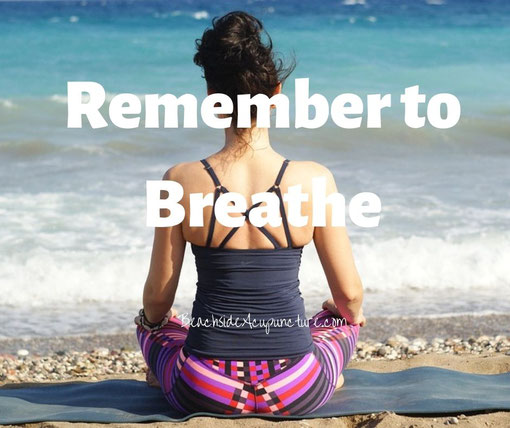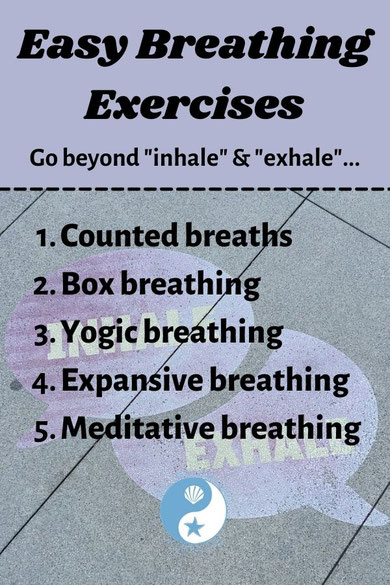
The body is an amazing organism, constantly working on a million little jobs to keep you functional twenty-four hours per day, seven days per week, fifty-two weeks per year. One of its most important tasks is maintaining the exchange of beneficial oxygen with the waste product carbon dioxide, which is what we call "breathing". Breathing is unique in that it is both autonomic - meaning the body will take care of it whether we're focusing on it or not - and voluntary. In other words, your lungs will continue to inflate and deflate with air no matter what...but you can also control a lot of the process if you put your mind to it.
Many of us do not pay any attention to our breathing and therefore tend to take shallow breaths, not filling the lungs to capacity or emptying them completely. This leads to less oxygen coming into the body and less carbon dioxide being expelled from it, neither of which is optimal for health. While breathing can be inhibited by stress, medical conditions like COPD or asthma, smoking, muscle tightness, and a myriad of other factors, almost everyone can practice breathing exercises in order to make deep breaths the body's standard way of operating.
There are a variety of breathing exercises out there. Practice these simple habits to start and expand your horizons to others as you feel comfortable...
1. Counted Breaths
Instead of simply inhaling and exhaling, try drawing out the process by breathing in for a count of four and then breathing out for a count of four. If this seems too easy, increase the number of counts until it becomes more challenging, trying a five-count, six-count, and so on. You should notice that you're able to inhale and exhale for longer periods of time as you practice, and you can play with exhaling for more counts than you inhale if that feels right to you.
2. Box Breathing
Box breathing also involves counting your breaths, but instead of flowing from inhale to exhale and back, you'll add an additional count at the top of your inhale and bottom of your exhale. This becomes: Breathe in for four counts, hold your breath with your lungs full for four counts, breathe out for four counts, and hold your breath with your lungs empty for four counts. Just like before, if four seconds seems too short of a time for you, add more until you feel like you are challenged.
3. yogic Breathing
It's not just how long you breathe but where you breathe that impacts health, and yogic breathing emphasizes filling all of your air cavities. Sit up or lie flat with your hand on your abdomen and chest. As you inhale, focus on drawing the new air into the body with your diaphragm, feeling the hand on your abdomen move as your belly fills. Once it's full, continue the inhale to fill your chest, feeling the hand there move next. Finally, finish the inhalation by filling up the rest of your upper respiratory tract - above your lungs into your throat - until there's nowhere else for air to go. Then, exhale in the opposite direction, letting air out of your throat...then your chest...then your abdomen. This should mimic an ocean wave crashing onto a beach and may seem very forced at first. With practice, you'll notice that it becomes more natural, and you may even start to hear your breath make sounds like the tide as it moves deeply through the back of your throat.
4. Expansive Breathing
Did you know that you have small muscles between each of your ribs that allow your rib cage to expand in every direction? Most people focus on their chest moving forward and backward or upward and downward during their breathwork, but breathing into other areas of the torso can help loosen muscles and open up more room for clean air to fill. Place your hands on the sides of your rib cage, the back of your rib cage, or your upper back and intentionally try to breathe into that area, paying attention to any movement that you notice. You might not feel much movement right off the bat - many people are tight here! - but you should become more mobile with practice. Stretching, massage, and other therapies can also help unlock these areas so that you can go deeper into your breathing exercises.
5. meditative Breathing
Technically any of these exercises can count as meditation because you are taking the focus away from your thoughts and directing it toward yourself, but if you want to go a few steps further, add an intention to your breaths. You can repeat a word or phrase as you inhale and exhale, for instance telling yourself, "I breathe in love" and "I breathe out peace." If your mind starts to race, recognize the thoughts for what they are and then make the choice to bring your attention back to your breaths and mantra.

Aerobics, yoga, Qigong, and other forms of exercise will also strengthen breathing and should be added to your normal routine. However, the beauty of these breathing exercises is that they can be practiced anywhere, any time, for any amount of time, and can provide an element of quiet to a busy, stressful day. Practice them while doing chores, sitting in traffic, waiting for your next client to come in, relaxing during your acupuncture treatment... Your body will appreciate the extra oxygen and your mind will love the break as well!

Kathleen Ketola is a Licensed Acupuncturist and the owner of Beachside Community Acupuncture. She loves providing affordable acupuncture to the residents of McKinney, Texas, and surrounding cities like Prosper, Frisco, and Plano, but she also enjoys educating the general public on how acupuncture and Traditional Chinese Medicine (TCM) can treat everything from pain to infertility to stress and beyond. Click "Book Now" at the top of this page to book an appointment or feel free to contact her at (214) 417-2260.








